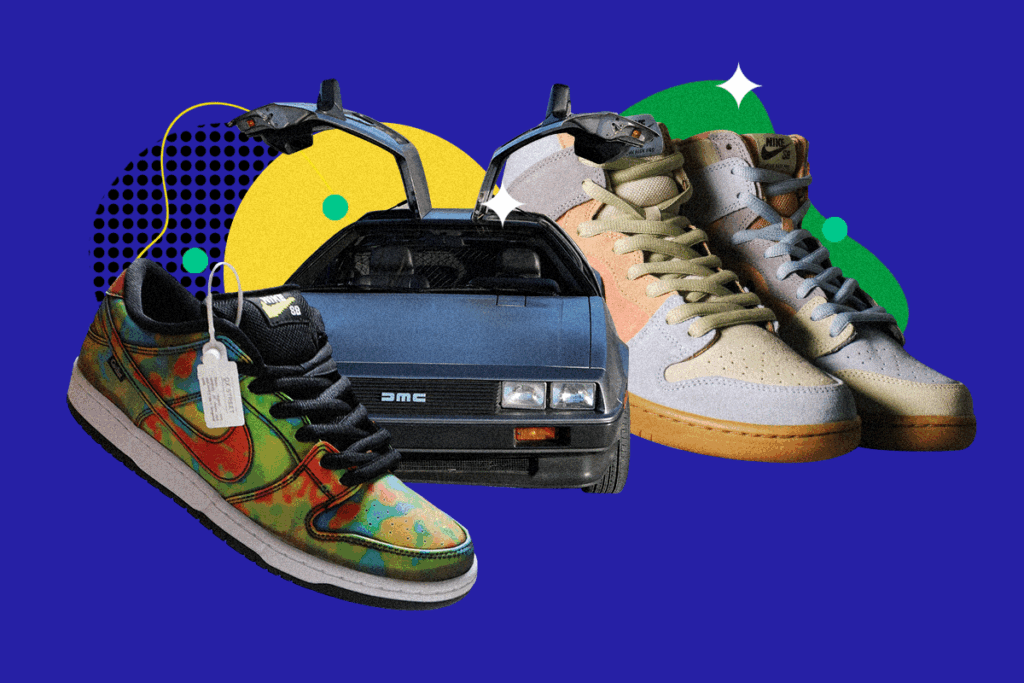Hype Prophet: A Guide to Reselling Sneakers & Streetwear
If reading up on stocks and bonds isn’t really your thing, why not try forecasting the next big sneaker drop instead?

Any Back to the Future fans in this corner of the interwebs?
Here’s an unpopular opinion: I think Biff was one savvy investor.
In Back to the Future Part II, old Biff goes back to 1985 and gives an almanac containing the results of future sporting events to his younger self, who then uses it to get rich through sports betting.
Genius move, right?
Just imagine if you could travel back to 2019 and give your younger self the 2020 StockX Snapshot to predict the most profitable sneakers and streetwear to flip. For instance, the 2,264% premium Nike SB Dunk Low Grateful Dead Bears Orange.
Unfortunately, I don’t have a DeLorean time machine I can lend you. Instead, we’re going to cover everything you need to know to spot, cop and profit off the next big streetwear and sneaker drops.
So lace up.
Get in on the ground floor of sneaker and streetwear reselling
Just a few decades ago, only a handful of insiders had the know-how and network to invest in sneakers and streetwear.
But with the rise of online communities, social media and marketplaces like StockX, today’s sellers are just a button or DM away from turning their kicks into cash.
Fortunes have been made flipping sneakers and streetwear
Sneakers in particular have been gobbling up most of the $15 billion fashion resale market. Not only was the global sneaker resale market valued at $6 billion just two years ago, it’s projected to 5x to $30 billion by 2030.
So how much money can a sole trader (pun intended) make in this biz?
In short: Millions. We’re talking enough money piled up at your feet that if Bow Wow stood on it he’d be taller than Shaq.
Still skeptical? Let me introduce you to some of the names behind the numbers:
- Benjamin Kickz built a million-dollar marketplace called Sneaker Don by the ripe age of 16. I, on the other hand, was off somewhere chasing skirts around that same age. Not a good resale investment, I know.
- JV from SixFigureSneakerhead clears over $100K a year flipping sneakers. And get this: he crossed $10K per month just 4 months into it.
But what does the average reseller’s returns look like? According to StockX, more than half of all their listings sold for multiples of 1x – 2x, while the average listing sells for a 1.48x retail multiple.
In other words, selling on StockX means you already have a 50% chance of doubling your money or at least breaking even. And if you’re part of the unicorn club (1% of StockX sales), you might even fetch a 5x – 10x premium.
How hype is manufactured in sneakers and streetwear
Hypebeasts admire exclusivity above all else. And to satisfy this need, sneaker and streetwear brands rely on the “drop” model. In other words, they intentionally understock items in a newly dropped collection. And like clockwork, hypebeasts all over the world wrestle to get their hands on the limited supply.
But exclusivity is only one tool in a sneaker or streetwear brand’s hype machine. And no, runway modeling has no place here. Hype is built by:
- Regular drop schedules to feed the frenzy, like Supreme’s famous Thursday morning 11 a.m. EST droplist.
- Intentional leaks that get fans to line up outside of stores, spread the word offline and on their social media accounts.
- Collaborations with celebrities, musicians and other popular brands, oftentimes luxury houses.
Last but not least: variety. Variety is the cousin of exclusivity, and helps sustain high demand. This might have to do with the fact that our collective attention spans are shorter than they’ve ever been.
Where was I again?
Oh yeah, variety. Streetwear brands don’t just peddle clothes and sneakers. All items and experiences are fair game, from money guns and bricks to performance art and fast food.
Anyone interested in a Supreme × John Wick pencil?
So how do you spot the next big sneaker and streetwear drops?
Like all other forms of investing, finding the year’s hottest sneakers to flip and figuring out the best streetwear brands to resell is a matter of buying low and selling high. Sounds simple enough, but the challenge here is:
- Finding items that will likely command high premiums
- Buying them at or near retail value
So how do you know what to buy when you’re just getting started?
The drivers of streetwear and sneaker resale value
There are a bunch of factors that influence high premiums, but the key ones are:
- Supply: The most important factor by far. Streetwear and sneakers that were produced in limited numbers sell out fast, causing prices to lift off like the Starman in Elon Musk’s Tesla Roadster.
- Brand collabs: While high-profile brands and limited collabs are safer bets, purely focusing on name recognition can be a bit hit (Nike × Off-White) and miss (adidas × Pharrell).
- Time since release: StockX data shows that many hyped releases follow a price curve, where prices are at their highest before a release, drop sharply right after release and then steadily climb back to their early highs. Keep this in mind to make sure you’re not the last one left holding the bag.
Here are some supporting factors:
- Men’s vs women’s: Men’s sneakers tend to have higher resale value than women’s.
- Size: Rare sizes (e.g. 4.5 for men and size 11.5 for women) command higher premiums.
- Colors: Rare colorways tend to perform better.
Spotting trends and getting in early
While no one can predict the next big drops with 100% accuracy, there are a few ways to spot them earlier than most.
News: Religiously follow fashion publications (Hypebeast, HighSnobiety, The Drop Date etc) to stay on top of new announcements. Also consider how other industries like art, film, music and sports might influence streetwear. This might help you get in early on the next unexpected collaboration, like the IKEA × Off-White “Keep Off” rug that’s currently selling at a 295% premium.
Community: Immerse yourself in streetwear and sneaker communities, both online and offline. Before the pandemic, you could hit up events like SneakerCon to see what’s hype in real life.
Social media: Follow retailers, publications and influencers on social media, particularly Twitter and Instagram.
By following owners, designers, PR people to store managers and sales associates, you’ll know about hot drops ahead of time. Ronnie Fieg, for instance, has been known to tweet about Kith drops earlier than the official brand account.
Marketplaces: You can calculate the profit potential of an upcoming release on marketplaces like eBay and StockX by looking at the resale history of similar or related items.
StockX even lets you monitor the demand and early sales for certain items before they’re officially released. You can use this data to identify the rare sizes or colorways, so you can get away with charging higher premiums.
How to resell sneakers and streetwear on StockX and other resale marketplaces
Every reseller has their own strategy: some people invest in a few limited releases and sit on them for months as they appreciate, while others prefer to move high volumes at slimmer margins.
Some of the best marketplaces and stores today are StockX, GOAT, Flight Club and Kick Game. Many resellers opt to use these middlemen because they get your product out in front of millions of buyers, which is especially useful if you don’t have a large network or following. They also authenticate sneakers and streetwear, so that buyers can rest easy at night knowing they didn’t blow their money on fakes.
Selling your sneakers or streetwear on StockX is a simple, 6-step process:
- Create an account.
- Search for the product you want to sell.
- Set the price you’d like to sell your item for with an “Ask”, or select “Sell Now” on the product page to immediately sell your item at the highest Bid.
- If you placed an Ask, then your item will be sold once it matches with a Bid.
- Ship the sold item to StockX within two business days.
- Once your items are received and authenticated by StockX, they release your payout. Do advise people to grab their umbrellas before you make it rain in the club.
Other ways to make money in the sneaker and streetwear resale market
Outside of reselling, here’s a short list of other creative ways to make a profit in this game.
1. Build a bot to do your bidding
Sneaker bots are programs that automate the online checkout process. And while sneaker companies do their best to combat bots (with raffle-only releases for example), it has become damn near impossible to cop new online drops without one. Talk about selling shovels in a gold rush. These bots can cost upwards of $500.
2. Bring the heat with a cook group
Cook groups are online communities (mostly on Discord) that provide their members with exclusive information on drops and access to tools like sneaker bots. They cost anywhere from $5 to $90/month. Some well-known cook groups include Polar Chefs, Winner’s Circle and Steady Soles.
3. Get paid to buy checks and stripes
Due to retailers limiting each buyer to a single pair, a reseller might offer to pay you to order a sneaker on their behalf. Not the most lucrative gig on this list, but it’s easy money.
4. Tired of drops? Then buy the stocks
If you’re looking for something more passive that doesn’t involve buying and selling drops, building software, or managing a community, then these are the next best options:
- Owning the hype machine itself. You can do this by buying stock in big companies like Nike and Adidas.
- Becoming a fractional owner of some of the world’s most valuable sneakers, like the 1985 Air Jordan 1 Chicago w/Black Sole, via collectible investing apps like Public and Rares. There’s no need to pay a small fortune for these drops. You can start buying and selling shares for as little as $10.
Alternative assets like collectibles—and basically anything other than stocks and bonds—also offer the benefit of diversification. In other words, if stocks tank but you’re also investing in sports memorabilia, or art, or sneakers, you don’t lose all your money.
